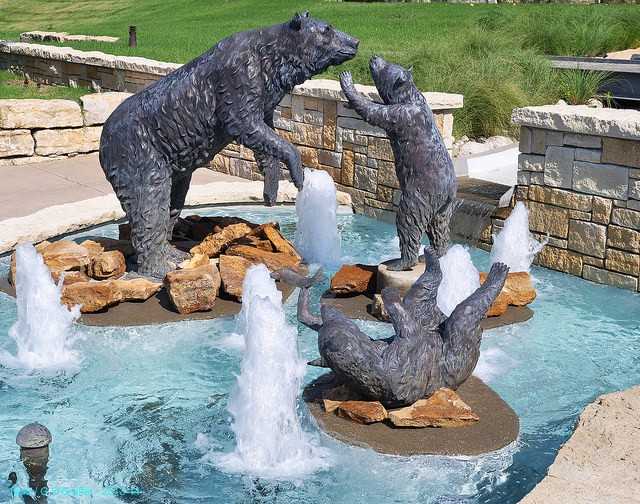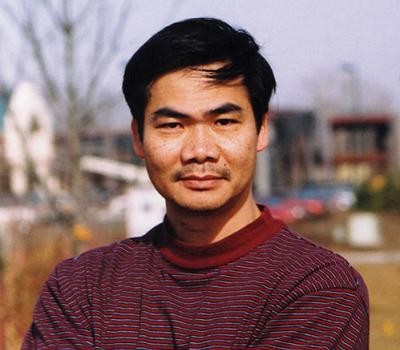Merriam Park: The Bear Pit
Introduction
Text-to-speech Audio
Images
"The Bear Pit" shows a mother bear attending to one cub, while the other tries to catch a fish. The sculptures are surrounded by a pool of water from the fountain. From G O'Graffer on Flickr.

Kwan Wu is a sculptor based in Kansas City. He began his work in China but eventually moved to the US after being sent to Kansas for work. From Kwan Wu Sculpture.

The image depicts a few of the many attractions found at Merriam Park. The bottom portion shows a line of people waiting at the railroad, while the other segments show various scenic areas that could be seen from within the park.

Backstory and Context
Text-to-speech Audio
“The Bear Pit” was installed outside of Merriam’s Visitors Bureau in 2006. It is a life-size sculpture made entirely of bronze that is used in conjunction with a fountain system. Also titled “Motherhood,” it depicts two bear cubs accompanying their mother. The mother appears to be directing her attention to one cub, while the other is preoccupied with trying to catch a fish that flew out of the water. The fountain begins in Shawnee Mission Parkway, containing four bubblers and a sign for the City of Merriam. The water trails underneath a walking path and ends up in the pool surrounding the bears with an additional seven bubblers. The sculpture and fountain were installed in 2006
Kwan Wu, a sculptor residing in Kansas City, created and built “The Bear Pit.” Wu grew up in China and was a promising sculptor from early on. He was scouted to attend China’s most prestigious art school along with only seven others. Four years later, he and one other student became the apprentices of Pan Ho, the Chinese National Sculptor. Several years later, Wu was Pan Ho’s most talented and capable apprentice; he was even in the position to replace him in the future. However, his work sent him to America for a few years, and he chose to stay, bringing his wife and son and helping them gain U.S. citizenship.
“The Bear Pit” is located over the area that used to be Merriam Park, from which Wu drew his inspiration for the sculpture. Merriam Park was an amusement park built on 40 acres of land by the Fort Scott and Gulf Railroad company as a way to lure people to the growing area and cultivate business opportunities. The park, designed by architect George Kessler, who later became one of the park’s superintendents, opened in July of 1880. The FS&G Railroad Company held a dedication ceremony featuring a speech by the current President, Ulysses S. Grant, who referred to the park as the “greatest amusement West of the Mississippi.” Admission to the park was a mere 25 cents (approximately $6.18 today), and it garnered thousands of visitors per day, reaching as high as 20,000 on their best days.
There were a variety of attractions in the park, including: a lagoon for sailboats or ice skating depending on the weather; areas designated for sports such as baseball, croquet, and tennis; a merry-go-round pulled by horses; at least one tree from every country in the world, an idea thought up by Kessler; and a small zoo. The zoo contained a large assortment of animals, but the most renowned are the park’s three bears. The legend states that the three bears were caught roaming around the park each night. They were never far from their designated area, but they were far enough that, most nights, they had to be escorted back. The bears were reportedly in pleasant moods when they were out, almost as if they simply wanted to roam.
Merriam Park was closed down in 1900 when Kansas City built its own attractions and parks to compete with the original. However, remnants of the park, namely the steps and the bear pits, were still extremely apparent even in the 1930s. Wu built the sculpture to commemorate this park, but it is far from the only thing in the area that is reminiscent of it. Kessler, after designing Merriam Park, was contracted to create a blueprint for the roads and parks in Kansas City. Because of this, the older parts of Kansas City look similar to how Merriam Park used to be laid out.
Cite This Entry
Skylar Rader and Amanda Shaver. "Merriam Park: The Bear Pit." Clio: Your Guide to History. December 15, 2018. Accessed March 22, 2025. https://theclio.com/entry/66706
Sources
https://www.hmdb.org/marker.asp?marker=46906.History of Merriam. Merriam. Accessed September 21, 2018.
https://www.merriam.org/DocumentCenter/View/39/History-of-Merriam?bidId=.Merriam Bear Pit Fountain. The City of Fountains Foundation. November 27, 2016. Accessed September 21, 2018.
https://www.kcfountains.com/single-post/2016/11/27/Merriam-Bear-Pit-Fountain. Merriam Visitors Guide. Explore Merriam, Kansas. Accessed September 21, 2018.
http://www.omagdigital.com/publication/?i=478145#{%22issue_id%22:478145,%22page%22:0}. The Bear Pit - Merriam Historic Plaza. Flickr. July 04, 2013. Accessed September 21, 2018.
https://www.flickr.com/photos/gograffer/14892579878. Thomas, Rachel. Turn O' The Century Kansas City Amusement. Flatland: KCPT'S Digital Magazine. August 06, 2018. Accessed October 01, 2018.
http://www.flatlandkc.org/curiouskc/curiouskc-amusement-parks-kansas-city/. Wu, Kwan. Kwan Wu's Story. Kwan Wu Sculpture. . Accessed September 21, 2018.
http://kwanwusculpture.com/html/story.html. 
